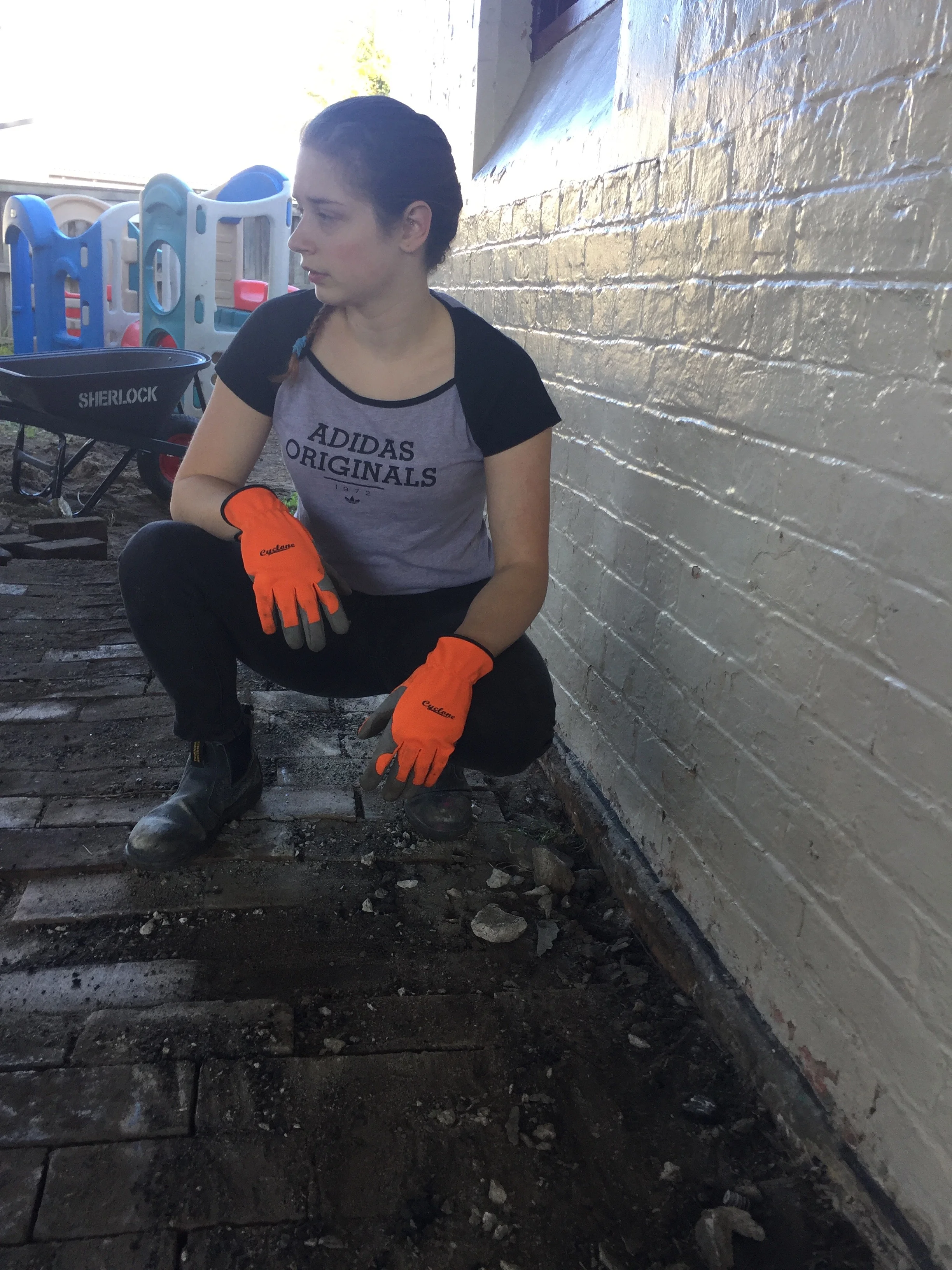When a school is cool in summer and warm in winter the children and teachers there enjoy a healthier and better learning place.
And a cool school achieves lower energy and water bills.
• Seizing things up: Zarah Copeland, Project Manager from Street Coolers, who put the project together, put on boots and gloves and made things happen - thanks, Zarah
Here’s an example of how a school is being cooled in summer, kept warmer in winter.
The vital ingredients for a stable temperature are trees and water.
And - importantly - pale, reflective colours for roofs and pavements, not dark ones, so the sun's heat is reflected, not absorbed so as to heat up the surface and air.
• Black bitumen being removed from the playground as tree roots had buckled it looking for air and water, and water ponded in it during rain, and the black material was heating up the school
Trees are free air conditioners. The higher and wider a tree’s canopy the more it cools the air below and nearby. And the more it keeps warm temperatures in winter.
To grow a tree needs three ‘foods’: air, nutrients and water.
• A Jacaranda tree root that's grown between bricks, searching for water and nutrients; the tree's trunk is about 15 metres away; the bricks were replaced by permeable paving to reduce drainage problems, help cool the school and reduce the 'aggression' of the roots - with water available to them roots can do their job without pushing up pavement searching for water and air
If a school has black bitumen playgrounds or pavements in the school, or adjoining it in the roads, these three vital ‘foods’ are denied, and any trees grow slowly, not much or die. The dark colour absorbs the sun's heat, increases air temperature and, in turn, the evaporation of soil moisture away from the tree roots all of which heats up the school and drives up cooling costs from air con.
Black bitumen absorbs the sun’s heat in summer days, and releases it at night, increasing the air temperatures day and night around a school by up to 6 to 10 degrees.
Worse, the bitumen treats the free rainwater that falls on it as a waste product and sends it away from any trees to street gutters to pollute harbours, rivers, and the ocean.
The example described here shows how a school has been cooled by replacing black bitumen with pale, water-absorbent – ‘permeable’ – pavement.
Importantly, the temperature at the school is being independently monitored by a world expert on thermal performance of buildings, roads, land and cities at the small and large scale, Professor Mat Santamouris and his colleagues at the University of New South Wales.
The Athena School was chosen by Michael Mobbs Sustainable Projects as its within a whole city block in Newtown, Sydney. This city block is being cooled by action research trials of different projects, designs and products over several years. The aim is to lower energy and water bills for local property owners and tenants by cooling the block and other options.
A research and development not-for-profit company, Street Coolers has a vision of cooling Australian cities by 2 degrees by 2020. Street Coolers is the delivery vehicle for the ideas along with partners from the area or with industry and research partners for different elements. An example of a local property owner participating in the trial is here.
In 2014 Street Coolers was given funding by the NSW government to begin the whole city block trial and lay the foundation for gathering temperature and energy use data.
My business, Michael Mobbs Sustainable Projects, is developing the ideas and partnering with others to refine and to develop the concepts, to build, and to monitor the results.
To cool the school there is a collaboration between the school, my business, Street Coolers, a landscape architecture firm, Taylor Brammer, a video artist who is helping us tell the stories, Lucia Alfonso, the company providing the permeable paving, Stoneset, and the University of New South Wales which is gathering and analysing the temperature data.
• Permeable paving may allow disconnection from existing, or avoid the need for, drains - reducing cost and maintenance; this drain discharges rain water onto the permeable paving allowing rainwater to be kept where it falls to feed the life in the soil below and the trees and tree roots which now have access to the water and air being delivered to them through the porous paving.
The permeable pavement in this project has these benefits and costs:
- No drains are needed in some areas as the rainwater is no longer treated as a waste product; instead, water is absorbed to feed the tree roots below the pavement;
- Maintenance, drain cleaning, flooding and associated costs and damage are avoided;
- Existing drains have been left in place but are no longer used, or are used rarely in times of extreme rainfall;
- Early, incomplete, data confirms other research into cool pavements, and suggests to me that the pale pavement is both reflecting the heat and retaining the coolness of the shade from the trees and cooling the air by over 2 degrees on days over 25 degrees, but it’s early days. At least another six months of data is needed before preliminary data may be analysed, conclusions reached and published;
- The costs of the permeable paving (including removing and recycling the asphalt, re-grading and laying foundation gravel and plastic formwork which was then filled with gravel and overlaid by the porous, recycled permeable pale material) will be published in another blog soon;
- The Atlantis Gravel Cell was provided at a reduced price and that price will be acknowledged in the next blog about the project costs, too;
- The savings in maintenance, energy and water bills for the school are being quantified as the impact of the cool pavement is measured in the years ahead.





